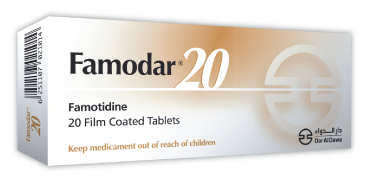Famodar® Is Famotidine
| Dosage form | Active Ingredient | Pack | |
| Tablet | Famotidine 20 mg | 20 tablets | |
| Tablet | Famotidine 40 mg | 10 tablets |
DESCRIPTION:
Famodar® is Famotidine, a long-acting histamine H2-receptor antagonist.
Famodar® tablets contain the coloring additive FD&C Yellow No. 6.
PHARMACOLOGY:
Famotidine reduces the basal, and stimulated gastric secretions. It has a rapid onset of action, the onset of the anti-secretory effect occurs within one hour and the maximum effect within one to three hours. The duration of action is long, but however, there is no cumulative effect with repeated doses.
INDICATIONS:
– Short term treatment of active duodenal ulcer.
– Maintenance therapy for duodenal ulcer patients at reduced dosage after healing of an active ulcer.
– Short term treatment of active benign gastric ulcer.
– Short term treatment of gastroesophageal reflux disease (GERD): Famodar®
is indicated for short term treatment of patients with symptoms of GERD and for the short term treatment of esophagitis due to GERD including erosive or ulcerative disease diagnosed by endoscopy.
– Treatment of pathological hypersecretory conditions (e.g., Zollinger-Ellison Syndrome, multiple endocrine adenomas).
CONTRAINDICATIONS:
Famodar® should not be used in the following cases:
– Hypersensitivity to any component of this product.
– A history of hypersensitivity to other H2-receptor antagonists.
SIDE EFFECTS:
The following adverse reactions have been reported to occur on therapy with famotidine in controlled clinical trials, and may be causally related to the drug:
headache, dizziness, constipation and diarrhea. The following other adverse reactions have been reported infrequently. The relationship to therapy with famotidine has been unclear in many cases. Within each category the adverse reactions are listed in order of decreasing severity:
– Body as a whole: fever, asthenia, fatigue.
– Cardiovascular: arrhythmia, AV block, palpitation.
– Gastrointestinal: cholestatic jaundice, liver enzyme abnormalities, vomiting,
nausea, abdominal discomfort, anorexia, dry mouth.
– Hematologic: rare cases of agranulocytosis, pancytopenia, leukopenia,
thrombocytopenia.
– Hypersensitivity: anaphylaxis, angioedema, orbital or facial edema, urticaria,
rash, conjunctival injection.
– Musculoskeletal: musculoskeletal pain including muscle cramps, arthralgia.
– Nervous System/Psychiatric: grand mal seizure; psychic disturbances, which
were reversible in cases for which follow-up was obtained, including hallucinations,
confusion, agitation, depression, anxiety, decreased libido; paresthesia; insomnia; somnolence.
– Respiratory: bronchospasm.
– Skin: toxic epidermal necrolysis (very rare), alopecia, acne, pruritus, dry skin, flushing.
– Special Senses: tinnitus, taste disorder.
– Others: rare
DRUG INTERACTIONS:
No drug interactions have been identified. Studies with famotidine in man, in animal models, and in vitro have shown no significant interference with the disposition of compounds metabolized by the hepatic microsomal enzymes, e.g., cytochrome P450 system. Compounds tested in man include warfarin, theophylline, phenytoin, diazepam, aminopyrine and antipyrine. Indocyanine green as an index of hepatic drug extraction has been tested and no significant effects have been found.
DOSAGE AND ADMINISTRATION:
Duodenal Ulcer Acute Therapy: The recommended adult oral dosage for active duodenal ulcer is
40 mg once a day at bedtime. Most patients heal within 4 weeks; there is rarely reason to use Famodar® at full dosage for longer than 6 to 8 weeks. A regimen of 20 mg b.i.d. is also effective.
Maintenance Therapy: The recommended adult oral dose is 20 mg once a day at bedtime.
Benign Gastric Ulcer Acute Therapy: The recommended adult oral dosage for active benign gastric
ulcer is 40 mg once a day at bedtime. Gastroesophageal Reflux Disease (GERD)
The recommended oral dosage for treatment of adult patients with symptoms of GERD is 20 mg b.i.d. for up to 6 weeks. The recommended oral dosage for treatment of adult patients with esophagitis including erosions and ulcerations and accompanying symptoms due to GERD is 20 or 40 mg b.i.d. for up to 12 weeks.
Pathological Hypersecertory Conditions (e.g., Zollinger-Ellison Syndrome, Multiple Endocrine Adenomas)
The recommended adult oral starting dose for pathological hypersecretory conditions is 20 mg q 6 h. In some patients, a higher starting dose may be required. Doses should be adjusted to individual patient needs and should continue as long as clinically indicated. Doses up to 160 mg q 6 h have been administered to some adult patients with severe Zollinger-Ellison Syndrome.
Concomitant Use of Antacids Antacids may be given concomitantly if needed. Dosage Adjustment for Patients with Moderate or Severe Renal Insufficiency Since CNS adverse effects have been reported in patients with moderate and severe renal insufficiency, to avoid excess accumulation of the drug in patients with moderate or severe renal insufficiency, the dose of Famodar® may be reduced to half the dose or the dosing interval may by prolonged to 36-48 hours as indicated by the patient’s clinical response.
OVERDOSAGE:
In the event of overdosage, treatment should be symptomatic and supportive. Unabsorbed material should be removed from the gastrointestinal tract, the patient should be monitored, and supportive therapy should be employed.
PRESENTATIONS:
Famodar® 20 Tablets: Packs of 20, 30 & 500 tablets. Each tablet contains 20mg Famotidine.
Famodar® 40 Tablets: Packs of 10 & 500 tablets. Each tablet contains 40mg Famotidine.
STORAGE CONDITIONS:
Protect from light. Store in a dry place below 25°C.
